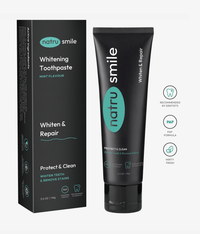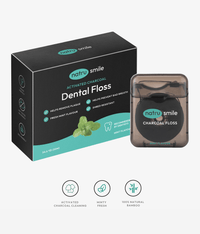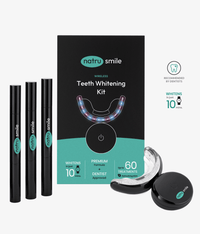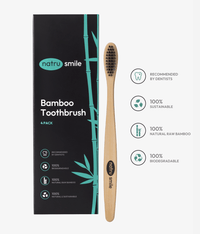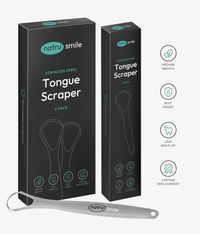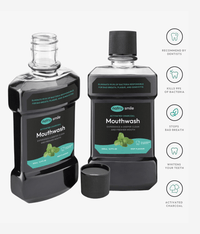
All products are certified by dental expert Dr. Greg Grillo
People often choose to whiten their teeth for aesthetic reasons, to achieve a brighter, whiter smile. Teeth whitening removes many types of stains, including those caused by tea, coffee, smoking, and other lifestyle habits.
There are two primary ways to whiten teeth:
- Over-the-counter products
- Professional teeth bleaching
The time it takes for teeth whitening to work depends on several factors, including the type of whitening procedure used and the degree of staining prior to treatment. Let's take a look at each whitening method and how long it takes to see results.
How Long Does It Take For Teeth Whitening Products To Whiten Teeth?
At-home teeth whitening works by using active ingredients such as hydrogen peroxide, carbamide peroxide, and/or sodium chlorite to break down stains on the enamel of the teeth. The bleaching agents in these products gradually lift away surface discolorations and help restore a brighter, whiter smile.
At-home whitening kits have come a long way, and there are several different kinds available. Here are the most popular home solutions and how long they take to whiten teeth:
- Whitening Strips: Whitening strips use a thin strip of flexible plastic covered with a layer of peroxide-based gel. These are applied directly to the teeth and left on for about 30 minutes. Some users see results immediately, but the real difference comes after using them for 3-4 days. However, whitening strips can be harmful to teeth if they are used to often.
- Whitening Gel: Whitening gels come either in ready-to-use syringes or as an activated chemical solution. The gel is applied to the teeth with a brush or tray and left on for around 15 minutes. Results are usually seen in 2-3 weeks due to the low concentration of peroxide.
- Whitening Toothpaste: Whitening toothpaste contains mild abrasives that help scrub away surface stains, but it usually takes several weeks of daily use for noticeable results (or longer if you have major stains). If you use purple-tinted whitening toothpaste, you can get white teeth in 3 minutes. But this toothpaste only cancels out yellow hues with purple—it does not yield lasting results.
- LED Teeth Whitening Kits: LED whitening kits use a bleaching agent in combination with a light-activated accelerator. These over-the-counter kits actually work, but they take a 2-4 weeks to show real results
Teeth whitening products you can use at home have been shown to be effective, but they can also pose significant risks to your dental health if you don't use them properly. It's important to follow the instructions closely and not overuse these products, or you could end up damaging your teeth and gums.
How Long Does It Take For In-Chair Teeth Whitening To Work?
In-office whitening includes professional bleaching and laser whitening.
Professional dental treatments such as laser whitening or chemical bleaching are more effective than over-the-counter products, with results that can be seen in a single session lasting as little as 30 minutes.
However, the amount of time it takes for teeth whitening to work can depend on the degree of staining prior to treatment and how much product is used. You might not get white teeth in 1 day, but you will certainly see results within the first 24 hours.
Tips To See Faster Results In Teeth Whitening
It's important to remember that teeth whitening solutions—professional or not—are not a cure-all for discolored teeth. The results you see from teeth whitening will depend largely on your lifestyle choices.
Here are a few tips to help you see quicker and better results from any teeth whitening procedure:
1. Pick The Right Teeth Whitening Products
The ideal teeth whitening solution for you will depend on your budget, time constraints, and teeth stain severity. When comparing at-home vs. in-office whitening, working under dental supervision is always the better option—but it can also be more expensive.
Professional testers have proven low-cost products like Crest whitening strips effective, but they may take longer to show results than more expensive methods. Gel applications are another viable option, with affordable kits available on Amazon, through reputable dental providers, and in supermarkets.
In-office whitening plans offer guidance and personalized treatment plans, so they are the most reliable option. Plus, the peroxide content in these products is higher and can work faster than those found in over-the-counter kits.
However, making consistent dental appointments can be difficult if you work with a popular dentist or work regular 9-5 hours. These treatments can also range from hundreds to thousands of dollars, making them cost-prohibitive for some individuals.
2. Stop Using Tobacco Products
If you chew tobacco or smoke cigars or cigarettes, the tar and nicotine in the products will cause teeth discoloration. For that matter, it's probably a major contributing factor to why your teeth are in need of whitening in the first place—roughly 28% of smokers have issues with teeth discoloration.
Cutting these products out entirely is the only real way to make whitening results last longer. Even if you use a professional whitening treatment, it won't last as long if you keep smoking.
More importantly, these products can have other dangerous implications for your oral hygiene, such as increasing risks of gum disease and oral cancer.
3. Practice Good Oral Hygiene Habits
Often, teeth whitening customers forget that these procedures aren't substitutes for basic oral hygiene habits. They are merely supplements.
Regular brushing and flossing are essential for keeping your teeth white, as well as preventing tooth decay and cavities. Doing so allows you to remove plaque—a biofilm that clings to the surface of your teeth and can cause discoloration over time.
Brushing your teeth twice a day (once in the morning and once at night) should do the trick, but be careful not to use whitening toothpaste. A March 2022 study from F1000Research reported significant disintegration of the mineral content in tooth enamel after using whitening toothpastes with abrasive ingredients.
Instead, opt for a milder fluoride-based toothpaste that is specifically formulated to clean and protect your teeth. This will help prevent any further discoloration while simultaneously preserving the results of your teeth whitening procedure.
4. Avoid Wine, Coffee, And Tea
Cutting wine, tea, and coffee out of your routine may seem impossible. And according to personal accounts, you can still see results from whitening without cutting out these drinks entirely.
However, the tannins in wine, coffee, and tea are notorious for staining teeth as soon as liquid touches enamel. If you're looking for longer-lasting whitening results, reducing your consumption of these beverages can be beneficial.
Of course, this isn't an all-or-nothing proposition. If you do choose to indulge in these drinks, make sure to rinse your mouth out with water afterward so the tannins don't get a chance to settle in and discolor your teeth over time.
5. Eat Fewer Foods With Added Sugar
Aside from tobacco and certain drinks, your diet can also affect how long teeth whitening results last. Sugars are one of the most common factors contributing to tooth discoloration (among other dental problems).
Refined sugars—which include added sugars like table sugar, high fructose corn syrup, brown sugar, honey, and maple syrup—are especially notorious for causing discoloration and cavities.
Reducing your intake of sugar can help prevent teeth discoloration and protect the results of your whitening treatments. Eating fruits and vegetables instead of sweet snacks is one way to make sure you're getting enough nutrients without sacrificing the bright, white smile you deserve.
The Takeaway
If you want a whiter and brighter smile, teeth-whitening solutions are certainly viable options. But keep in mind that your results won't last forever—you will need to keep up with good oral health and dietary habits to maintain your results.
The good news is that these are all easy things you can do on your own, so there's no excuse not to take advantage of the bright smile you've earned! With a little diligence and effort, you can keep your teeth looking their best for years to come.
Want to know more? Here are a few questions our customers frequently ask us:
How Long Does It Take To Go From Yellow To White Teeth?
The amount of time it takes to go from yellow to white teeth depends on the type of whitening procedure you use and how severe your discoloration is. Some over-the-counter products take several weeks, while others work almost immediately. Professional whitening shows visible results in under 24 hours, but to achieve full whitening, multiple treatments are required.
Can Teeth Whitening Work After 1 Day?
Some over-the-counter products (e.g., purple toothpaste, whitening strips, or gels) may show immediate results. But these often don't do much below the enamel—they only cancel out the surface colors for a short period. Professional whitening solutions show their first results within 24 hours, but you will still need consistent treatment over the course of several weeks to achieve full whitening.
What Foods Should I Avoid After Teeth Whitening?
After a teeth-whitening treatment, foods and beverages containing tannins—like coffee, tea, and red wine—should be avoided as much as possible. Cut back on sugary snacks like candy and soda, too—these can cause cavities and discoloration over time. Sticking to fresh fruits, vegetables, and whole grains is key for maintaining your results.
How Long Does It Take To See Results With Teeth Whitening Trays?
You can expect to see some results after about one week of treatment. But for full whitening, it usually takes two weeks for teeth that are less discolored and up to a month for more severe discoloration.
How Long To See Results With Whitening Toothpaste?
If you use whitening toothpaste twice daily, you can expect to see visible results in two to six weeks. However, those that contain blue covarine, like some of the popular charcoal toothpastes, can show results immediately.
How Long To See Results With Teeth Whitening Strips?
After using whitening strips for 3-4 days in a row, you can expect to see some visible results. However, it's important to read the label and only use the strips for the recommended number of days to achieve the desired results.


